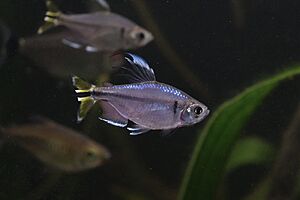Yellow-tailed African tetra facts for kids
Quick facts for kids Yellow-tailed African tetra |
|
|---|---|
 |
|
| Conservation status | |
| Scientific classification |
The yellow-tailed African tetra is a cool freshwater fish. Its scientific name is Alestopetersius caudalis. You can find it living in the Congo River basin in Africa. It lives in countries like the Democratic Republic of the Congo.
This fish is an omnivore, meaning it eats both plants and animals. In the wild, it enjoys small insects, tiny water creatures, and even fruits that fall into the water.
Contents
About the Yellow-Tailed Tetra
The yellow-tailed African tetra is a small, active fish. It gets its name from its tail, which often has a yellow color. These fish are known for being peaceful and fun to watch.
What They Eat
In their natural home, these tetras eat many different things. They munch on small insects and tiny creatures that live in the water. They also eat fruits that drop into the river.
If you keep them in an aquarium, they can easily eat regular fish food. You can also feed them special treats. These include daphnia, bloodworms, and artemia. Make sure their food includes some plant material too.
Where They Live
The yellow-tailed African tetra lives in the Congo River basin. This is a huge river system in central Africa. They are found in the Democratic Republic of the Congo. There are also reports of them in the Republic of the Congo.
Caring for Them in an Aquarium
If you want to keep these fish, they need the right water. They like their water to be soft. The best temperature for them is between 22 and 26 degrees Celsius (72-79 degrees Fahrenheit). The water's pH level should be between 5.0 and 7.5.
How Males and Females Look Different
Adult male yellow-tailed tetras are usually more colorful than females. They also tend to grow a bit faster. Males have longer fins that are tipped with white. These special fin tips are found on their dorsal, ventral, caudal, and anal fins. Females do not have these white tips.
Reproduction and Life Cycle
Yellow-tailed African tetras lay their eggs by scattering them. This means they do not build nests. They also do not take care of their babies.
One way to help them breed is to set up a special tank. You can keep a group of adult fish in this tank. People often use a special "trap" to collect the eggs. This trap helps keep the eggs safe.
After the eggs are laid, they are moved to a smaller container. The tiny baby fish, called fry, hatch there. At first, they eat very tiny foods. As they grow bigger, they can start eating foods like daphnia.
Conservation Status
The yellow-tailed African tetra is listed as a species of "least concern" by the IUCN Red List. This means that their population in the wild is stable. There are no major threats to them right now.


